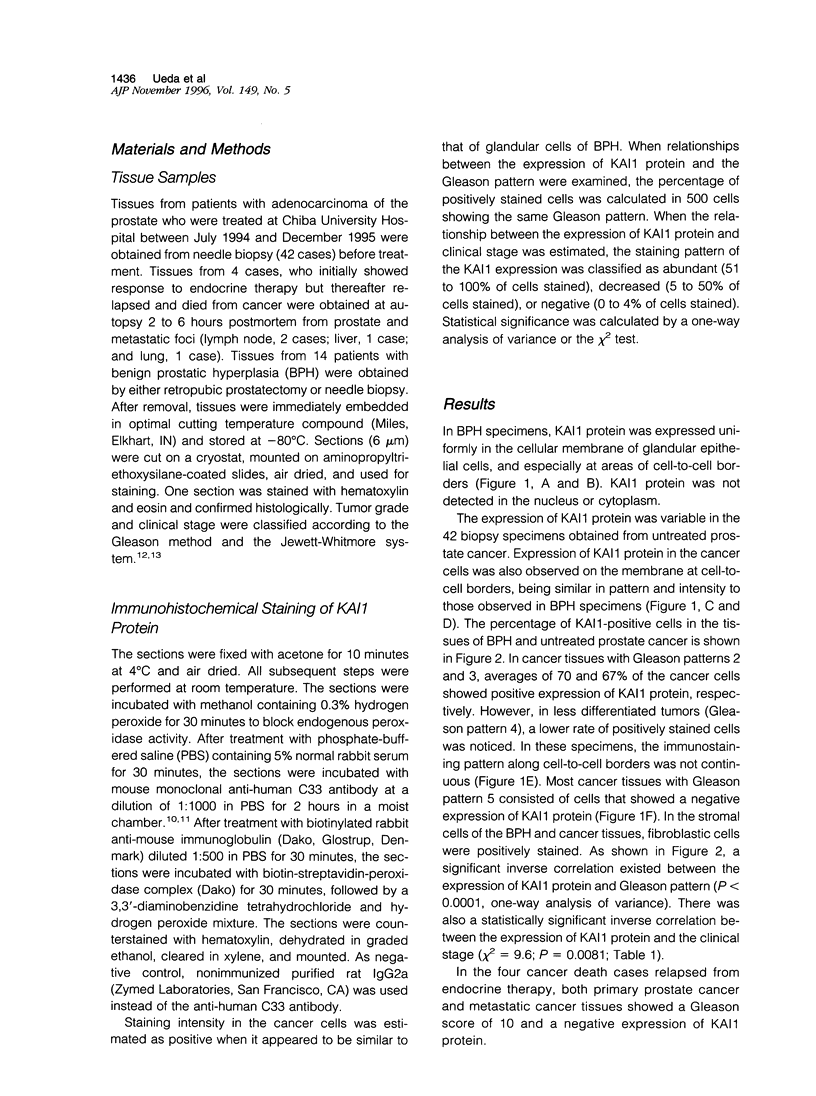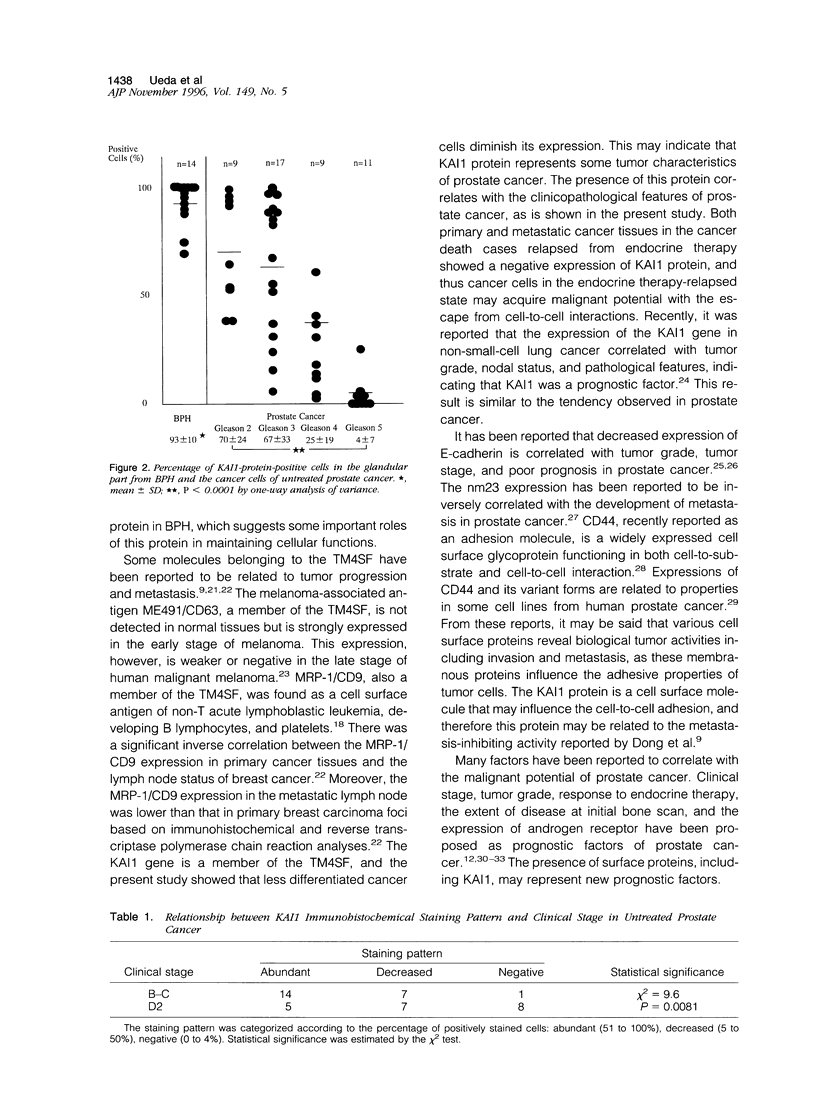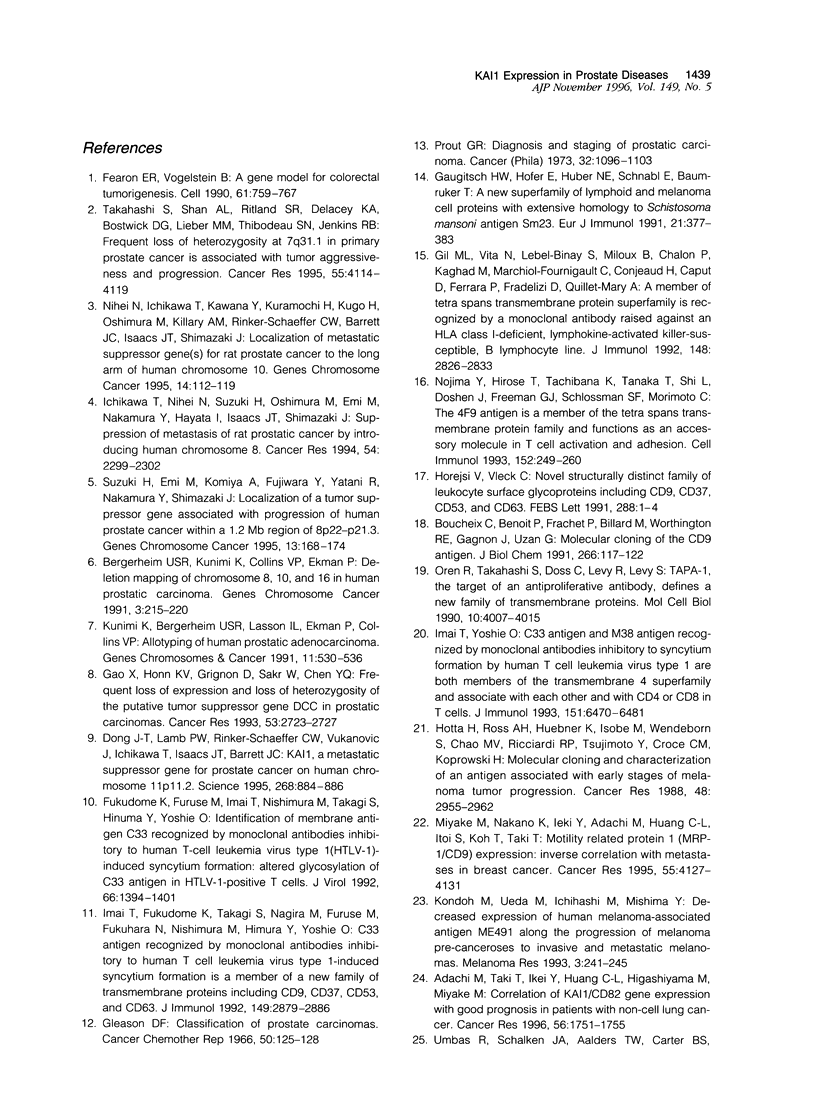Abstract
The KAI1 gene, recently identified as a metastatic suppressor gene for prostate cancer, was cloned and was revealed to be identical to the C33/IA4/ R2/4R9 gene. The expression of KAI1 protein was examined immunohistochemically in the tissues from 14 cases of benign prostatic hyperplasia and 46 cases of prostate cancer using mouse monoclonal anti-human C33 antibody. In benign prostatic hyperplasia tissues, KAI1 protein was uniformly expressed in the glandular cell membrane at cell-to-cell borders. The KAI1 protein in the tissues of untreated prostate cancer was also located at similar sites to those of benign prostatic hyperplasia, but the percentage of strongly positive cancer cells was correlated inversely to the Gleason pattern (P < 0.0001, one-way analysis of variance). There was also a statistically inverse correlation between the percentage of KAI1-positive cancer cells and the clinical stage (chi 2 = 9.6; P = 0.0081). In 4 cancer death cases relapsed from endocrine therapy, KAI1 protein was not stained in either primary or metastatic foci. These results indicate that the expression of KAI1 protein correlates to tumor characteristics in prostate cancer.
Full text
PDF





Images in this article
Selected References
These references are in PubMed. This may not be the complete list of references from this article.
- Adachi M., Taki T., Ieki Y., Huang C. L., Higashiyama M., Miyake M. Correlation of KAI1/CD82 gene expression with good prognosis in patients with non-small cell lung cancer. Cancer Res. 1996 Apr 15;56(8):1751–1755. [PubMed] [Google Scholar]
- Bergerheim U. S., Kunimi K., Collins V. P., Ekman P. Deletion mapping of chromosomes 8, 10, and 16 in human prostatic carcinoma. Genes Chromosomes Cancer. 1991 May;3(3):215–220. doi: 10.1002/gcc.2870030308. [DOI] [PubMed] [Google Scholar]
- Boucheix C., Benoit P., Frachet P., Billard M., Worthington R. E., Gagnon J., Uzan G. Molecular cloning of the CD9 antigen. A new family of cell surface proteins. J Biol Chem. 1991 Jan 5;266(1):117–122. [PubMed] [Google Scholar]
- Dong J. T., Lamb P. W., Rinker-Schaeffer C. W., Vukanovic J., Ichikawa T., Isaacs J. T., Barrett J. C. KAI1, a metastasis suppressor gene for prostate cancer on human chromosome 11p11.2. Science. 1995 May 12;268(5212):884–886. doi: 10.1126/science.7754374. [DOI] [PubMed] [Google Scholar]
- Emrich L. J., Priore R. L., Murphy G. P., Brady M. F. Prognostic factors in patients with advanced stage prostate cancer. Cancer Res. 1985 Oct;45(10):5173–5179. [PubMed] [Google Scholar]
- Fearon E. R., Vogelstein B. A genetic model for colorectal tumorigenesis. Cell. 1990 Jun 1;61(5):759–767. doi: 10.1016/0092-8674(90)90186-i. [DOI] [PubMed] [Google Scholar]
- Fukudome K., Furuse M., Imai T., Nishimura M., Takagi S., Hinuma Y., Yoshie O. Identification of membrane antigen C33 recognized by monoclonal antibodies inhibitory to human T-cell leukemia virus type 1 (HTLV-1)-induced syncytium formation: altered glycosylation of C33 antigen in HTLV-1-positive T cells. J Virol. 1992 Mar;66(3):1394–1401. doi: 10.1128/jvi.66.3.1394-1401.1992. [DOI] [PMC free article] [PubMed] [Google Scholar]
- Gao X., Honn K. V., Grignon D., Sakr W., Chen Y. Q. Frequent loss of expression and loss of heterozygosity of the putative tumor suppressor gene DCC in prostatic carcinomas. Cancer Res. 1993 Jun 15;53(12):2723–2727. [PubMed] [Google Scholar]
- Gaugitsch H. W., Hofer E., Huber N. E., Schnabl E., Baumruker T. A new superfamily of lymphoid and melanoma cell proteins with extensive homology to Schistosoma mansoni antigen Sm23. Eur J Immunol. 1991 Feb;21(2):377–383. doi: 10.1002/eji.1830210219. [DOI] [PubMed] [Google Scholar]
- Gil M. L., Vita N., Lebel-Binay S., Miloux B., Chalon P., Kaghad M., Marchiol-Fournigault C., Conjeaud H., Caput D., Ferrara P. A member of the tetra spans transmembrane protein superfamily is recognized by a monoclonal antibody raised against an HLA class I-deficient, lymphokine-activated killer-susceptible, B lymphocyte line. Cloning and preliminary functional studies. J Immunol. 1992 May 1;148(9):2826–2833. [PubMed] [Google Scholar]
- Gleason D. F. Classification of prostatic carcinomas. Cancer Chemother Rep. 1966 Mar;50(3):125–128. [PubMed] [Google Scholar]
- Horejsí V., Vlcek C. Novel structurally distinct family of leucocyte surface glycoproteins including CD9, CD37, CD53 and CD63. FEBS Lett. 1991 Aug 19;288(1-2):1–4. doi: 10.1016/0014-5793(91)80988-f. [DOI] [PubMed] [Google Scholar]
- Hotta H., Ross A. H., Huebner K., Isobe M., Wendeborn S., Chao M. V., Ricciardi R. P., Tsujimoto Y., Croce C. M., Koprowski H. Molecular cloning and characterization of an antigen associated with early stages of melanoma tumor progression. Cancer Res. 1988 Jun 1;48(11):2955–2962. [PubMed] [Google Scholar]
- Ichikawa T., Nihei N., Suzuki H., Oshimura M., Emi M., Nakamura Y., Hayata I., Isaacs J. T., Shimazaki J. Suppression of metastasis of rat prostatic cancer by introducing human chromosome 8. Cancer Res. 1994 May 1;54(9):2299–2302. [PubMed] [Google Scholar]
- Imai T., Fukudome K., Takagi S., Nagira M., Furuse M., Fukuhara N., Nishimura M., Hinuma Y., Yoshie O. C33 antigen recognized by monoclonal antibodies inhibitory to human T cell leukemia virus type 1-induced syncytium formation is a member of a new family of transmembrane proteins including CD9, CD37, CD53, and CD63. J Immunol. 1992 Nov 1;149(9):2879–2886. [PubMed] [Google Scholar]
- Imai T., Yoshie O. C33 antigen and M38 antigen recognized by monoclonal antibodies inhibitory to syncytium formation by human T cell leukemia virus type 1 are both members of the transmembrane 4 superfamily and associate with each other and with CD4 or CD8 in T cells. J Immunol. 1993 Dec 1;151(11):6470–6481. [PubMed] [Google Scholar]
- Kondoh M., Ueda M., Ichihashi M., Mishima Y. Decreased expression of human melanoma-associated antigen ME491 along the progression of melanoma pre-canceroses to invasive and metastatic melanomas. Melanoma Res. 1993 Aug;3(4):241–245. [PubMed] [Google Scholar]
- Konishi N., Nakaoka S., Tsuzuki T., Matsumoto K., Kitahori Y., Hiasa Y., Urano T., Shiku H. Expression of nm23-H1 and nm23-H2 proteins in prostate carcinoma. Jpn J Cancer Res. 1993 Oct;84(10):1050–1054. doi: 10.1111/j.1349-7006.1993.tb02800.x. [DOI] [PMC free article] [PubMed] [Google Scholar]
- Kunimi K., Bergerheim U. S., Larsson I. L., Ekman P., Collins V. P. Allelotyping of human prostatic adenocarcinoma. Genomics. 1991 Nov;11(3):530–536. doi: 10.1016/0888-7543(91)90059-n. [DOI] [PubMed] [Google Scholar]
- Lesley J., Hyman R., Kincade P. W. CD44 and its interaction with extracellular matrix. Adv Immunol. 1993;54:271–335. doi: 10.1016/s0065-2776(08)60537-4. [DOI] [PubMed] [Google Scholar]
- Lokeshwar B. L., Lokeshwar V. B., Block N. L. Expression of CD44 in prostate cancer cells: association with cell proliferation and invasive potential. Anticancer Res. 1995 Jul-Aug;15(4):1191–1198. [PubMed] [Google Scholar]
- Miyake M., Nakano K., Ieki Y., Adachi M., Huang C. L., Itoi S., Koh T., Taki T. Motility related protein 1 (MRP-1/CD9) expression: inverse correlation with metastases in breast cancer. Cancer Res. 1995 Sep 15;55(18):4127–4131. [PubMed] [Google Scholar]
- Nihei N., Ichikawa T., Kawana Y., Kuramochi H., Kugo H., Oshimura M., Killary A. M., Rinker-Schaeffer C. W., Barrett J. C., Isaacs J. T. Localization of metastasis suppressor gene(s) for rat prostatic cancer to the long arm of human chromosome 10. Genes Chromosomes Cancer. 1995 Oct;14(2):112–119. doi: 10.1002/gcc.2870140205. [DOI] [PubMed] [Google Scholar]
- Nojima Y., Hirose T., Tachibana K., Tanaka T., Shi L., Doshen J., Freeman G. J., Schlossman S. F., Morimoto C. The 4F9 antigen is a member of the tetra spans transmembrane protein family and functions as an accessory molecule in T cell activation and adhesion. Cell Immunol. 1993 Nov;152(1):249–260. doi: 10.1006/cimm.1993.1285. [DOI] [PubMed] [Google Scholar]
- Oren R., Takahashi S., Doss C., Levy R., Levy S. TAPA-1, the target of an antiproliferative antibody, defines a new family of transmembrane proteins. Mol Cell Biol. 1990 Aug;10(8):4007–4015. doi: 10.1128/mcb.10.8.4007. [DOI] [PMC free article] [PubMed] [Google Scholar]
- Prout G. R., Jr Proceedings: Diagnosis and staging of prostatic carcinoma. Cancer. 1973 Nov;32(5):1096–1103. doi: 10.1002/1097-0142(197311)32:5<1096::aid-cncr2820320514>3.0.co;2-k. [DOI] [PubMed] [Google Scholar]
- Schröder F. H., Hermanek P., Denis L., Fair W. R., Gospodarowicz M. K., Pavone-Macaluso M. The TNM classification of prostate cancer. Prostate Suppl. 1992;4:129–138. doi: 10.1002/pros.2990210521. [DOI] [PubMed] [Google Scholar]
- Soloway M. S., Hardeman S. W., Hickey D., Raymond J., Todd B., Soloway S., Moinuddin M. Stratification of patients with metastatic prostate cancer based on extent of disease on initial bone scan. Cancer. 1988 Jan 1;61(1):195–202. doi: 10.1002/1097-0142(19880101)61:1<195::aid-cncr2820610133>3.0.co;2-y. [DOI] [PubMed] [Google Scholar]
- Suzuki H., Emi M., Komiya A., Fujiwara Y., Yatani R., Nakamura Y., Shimazaki J. Localization of a tumor suppressor gene associated with progression of human prostate cancer within a 1.2 Mb region of 8p22-p21.3. Genes Chromosomes Cancer. 1995 Jul;13(3):168–174. doi: 10.1002/gcc.2870130306. [DOI] [PubMed] [Google Scholar]
- Takahashi S., Shan A. L., Ritland S. R., Delacey K. A., Bostwick D. G., Lieber M. M., Thibodeau S. N., Jenkins R. B. Frequent loss of heterozygosity at 7q31.1 in primary prostate cancer is associated with tumor aggressiveness and progression. Cancer Res. 1995 Sep 15;55(18):4114–4119. [PubMed] [Google Scholar]
- Umbas R., Isaacs W. B., Bringuier P. P., Schaafsma H. E., Karthaus H. F., Oosterhof G. O., Debruyne F. M., Schalken J. A. Decreased E-cadherin expression is associated with poor prognosis in patients with prostate cancer. Cancer Res. 1994 Jul 15;54(14):3929–3933. [PubMed] [Google Scholar]
- Umbas R., Schalken J. A., Aalders T. W., Carter B. S., Karthaus H. F., Schaafsma H. E., Debruyne F. M., Isaacs W. B. Expression of the cellular adhesion molecule E-cadherin is reduced or absent in high-grade prostate cancer. Cancer Res. 1992 Sep 15;52(18):5104–5109. [PubMed] [Google Scholar]



